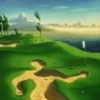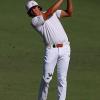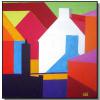Warning... long read
Starting around post #41 in "An apple falls from a tree" thread, there's some very interesting discussion about how the levels of difficulty can be programmed into the game. Most of the ideas focused on the swing meter itself and the amount of information given to the player on the screen.
The swing meter images posted by IanD and Kablammo dealt with the click based swing, which presents unique problems when trying to determine levels of difficulty. A comprehensive mouse movement based swing (I'll use PowerStroke from LINKS as an example) has enough player input to determine clubhead speed, face angle, club path, quality of strike, and timing of release to calculate the ball flight. The benefit of this is that it is likely the truest representation to date of how well the player can "swing" (swing meaning being responsible for as many of the parameters of a golf swing in a logical way on a computer). The drawback... it's very difficult and most didn't have the patience to learn the system. Some found it awkward to use.
The click swing (full disclosure, my preferred method) demands very little from the user except for a few brief moments of hand-eye coordination. Not saying it's easy, but in comparison to something like PS, there's less "to do"
So the reason I'm blathering on is this: PG is using Trackman data/real life physics to program the gameplay. If easier levels lessen the distance/direction penalty for mishits, this means it has abandoned the true ball flight physics data that is the core of the game. At that point the club/ball have become self correcting.
Since a player earns his ball flight more with a comprehensive mouse movement based swing, it automatically creates levels of separation of players based on the amount of input required. Especially in terms of distance, some folks can just create more clubhead speed than others.
For the clickers, how do we separate players on different levels of difficulty? Links did this with variations of sidehill lie effects and increased missed snap penalties (also Elite levels had no top cam aiming)
I feel it should all be in the swing. But maybe there should be a trade-off...
Both IanD and Kablammo had interesting thoughts about lessening the amount of lines/numbers/percentages on the swingmeter itself for harder levels, and placing emphasis on the value of rhythm. Lessening the amount of help/information on the swing meter does make it more difficult to judge shots. One problem is that it doesn't address the problem of all clickers being at a standard distance level.
So an interesting thought for clickers is "how can one player create more clubhead speed than the other player?" Usually we have a stock meter and although you can try to overswing for a little more, there's always distance "given" to us with a click swing.
RHYTHM and TIMING. More for us players "to do"
What if to hit the ball farther with a click swing, you have to do more?
In other golf games, there's no reward within the game for doing more or having less help. It's just harder. Yes it's a welcome challenge, but the player in the game doesn't have anything to balance out against someone at an easier swing level. The game plays out fairway to green just like the other player. The holes don't "feel" different to players on harder levels. The same players are confined by the same hazards because of their distance.
So here's the tradeoff...
How about easier levels have less "given" distance, and in order for a player to hit professional level distances, they have to accept more to do. What if that means an easier swing meter doesn't get you 280-290 yards with your driver? (I can hear the boos now) With a system like this, we may finally see a bunch of clickers not having the same distance approach shot into the greens or using the same clubs on par 3s.
How do we incorporate things like rhythm and timing and a strong release of the clubhead into a click swing?
Progressively faster meters are one way, and although potentially unpopular, does make some sense to me. The faster the meter, the more clubhead speed represented and more timing dependent it becomes. The faster meters can hit it far, but potentially very crooked (not because of increased mishit penalties, but because it's just harder to time it right).
I want to clarify, I'm not talking about crazy fast swing meters here. Maybe a range to choose from and the player is free to accept whatever challenge they see fit.
Also suggested was a partially obscured swing meter to rely more on feel than just the visual meter. Again, maybe a range of visual obstruction to choose from.
Any other thoughts on this? Am I completely crazy? Probably.






















